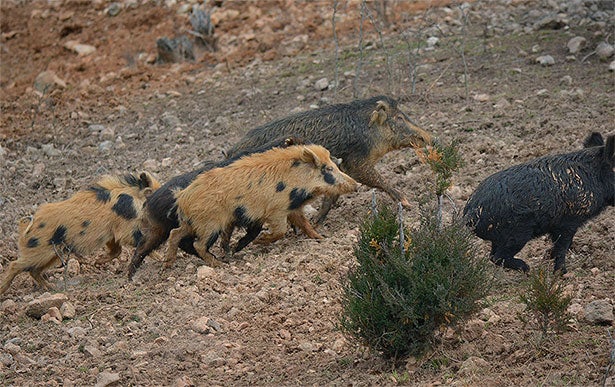Going Hog Wild for Off-Season Porkers
OutdoorChannel.com 05.20.15

By: Posted 05-19-2015 OutdoorChannel.com in Hunting by Lynn Burkhead
Permitted use provided by: OutdoorChannel.com.
Depending upon your perspective, my home state of Texas is blessed, or cursed if you’re a rancher or farmer, with an abundance of wild hogs.
While no one seems to know for sure just how many feral swine there are in the state, some recent estimates have placed the Lone Star State’s wild porker population at 2.5 million pigs – and counting.
Adaptable to a wide range of habitat from the beach to the mountains, Texas pigs are plentiful in the Trans Pecos desert, the Panhandle’s flat prairies, the river bottoms of East Texas, the rolling terrain of the Hill Country, and even down into the prickly pear cactus flats of South Texas and its well-known Brush Country.
In short, wild hogs are just about everywhere in the state of Texas and are found in nearly all of the state’s 254 counties. And that’s no braggadocios 10-gallon hat-size claim either.
So what’s a Lone Star State hunter to do this month with spring turkey hunting season winding down and fall deer season still months away?
Simple, get out and get about the business of putting a serious dent into the wild pig population of Texas.
First introduced in 1539 into what is now Texas by explorer Hernando de Soto, feral pig herds expanded across the state through the mid-1600s when the LaSalle expedition brought even more hogs to portions of the Texas Gulf Coast.
Expanding from those original introductions, plenty of other porkers have escaped down through the years from agricultural corrals, adding even more rooters to the state’s burgeoning herd.
While most of the state’s wild pigs are simply domesticated hogs that have escaped and gone wild, some hunters claim that the occasional European-stock Russian boar still exists, especially in the Pineywoods region of East Texas.
Regardless of the wild pig’s lineage, coloration of hogs can vary from a variety of solid colors to various spotted or belted combinations.
While the occasional monster hogzilla weighing 400-plus pounds and sporting 5-inch tuskers is harvested, most boars average between 100 to 200 pounds with smaller tusks. Sows are smaller and generally average slightly more than 100 pounds in weight.
If you’re interested in hunting these wild pigs somewhere in Texas this year, then keep in mind that there are several ways to get into the pig hunting game here, including on public land through the purchase of the Texas Parks and Wildlife Department’s $48 Annual Public Hunting (APH) permit.
While not all public land hunting locations in Texas support wild hog populations or allow for pig hunting, many do. And since the APH provides access to nearly one million acres of public ground at nearly 180 locations, there is some public hunting opportunity here in a state where 97 percent of the land is behind private lock-and-key.
Another option for would-be hog hunters is provided through TPWD’s special draw hunts. While the deadline for applying for these special hunt permits has already passed for the current year, standby spots can sometimes be available for opportunistic hunters. For more information, visit TPWD’s website at www.tpwd.state.tx.us or call 1-800-792-1112.
Two final hog hunting options in the state include hunting by way of a day-lease operation (check local newspaper classified ads or various online hunting sites) or through a guided hunt offered by an outfitter like North Texas wild hog expert J.J. Kent (www.kentoutdoors.com; 903-271-5524).
If you choose either one of these options, expect to pay anywhere from $50 per day for trespass fees on a farmer’s field on up to $1,500 for a multi-day package hunt at a nice hunting lodge.
While wild pigs are an unprotected, non-game animal in the Lone Star State, hunters must still have a valid hunting license and any valid stamp endorsements to legally hunt the feral swine.
Once properly licensed, a hunter may then employ a variety of hunting methods including the two most often used in the state, hunting from a stand over bait or spot-and-stalk hunting with a bow or gun.
I’ve employed both methods during my pig hunting activities, including the downing of a 230-pound boar with a long snout that tried to sneak into a whitetail food plot I was guarding a few years back.
When he got within 30 yards, my Mathews compound bow spoke loud and clear and turned the lights out on the big boar for good. After the Muzzy broadhead and Easton arrow found their mark, I was left with plenty of pork for the freezer and a unique trophy for the wall.
I’ve killed other wild pigs in North Texas while hunting, still more in South Texas while spring turkey hunting and have even had the chance to do so in the arid reaches of West Texas.
In fact, the biggest wild hog I’ve ever laid eyes on was near Quanah, Texas one spring as I was turkey hunting out west. The only reason that I didn’t kill the huge boar, one that my hunting buddy and I estimated to be more than 400 pounds, is that I didn’t figure a #6 copper-plated turkey shot would do much more than make the big hog mad at me.
Keep in mind that despite their abundance, feral hogs are no pushovers in whatever portion of the state they call home. Sporting keen senses of smell and hearing to go with fair eyesight, stalking these animals also can hold just a twinge of danger at times.
In fact, when cornered or wounded, a big wild boar can easily pass for a poor man’s grizzly bear, looking for a fight with his tusks and brute strength instead of a speedy flight into escape cover.
While they aren’t the easiest critters to hunt – wild hogs can become every bit as nocturnal as whitetails do when they feel hunting pressure – they aren’t terribly hard to find since signs that these big rooters leave behind are hard to miss.
Look for tracks, smelly wallows in swampy areas, muddy rubs on fence posts or trees, coarse hair left behind at fence crossings, and torn-up turf and agricultural fields where the swine root for food. Find a combination of all of the above, and you’re probably not far from ground zero in terms of your local swine herd’s preferred location.
If a big trophy tusker is the goal, keep in mind that most such boars are solitary animals, preferring moist, dense cover and associating with family herds of sows and piglets primarily during the breeding season.
Also, keep in mind that feral hogs in general, and trophy-size boars in particular, are particularly tough critters to bring down even when found, regardless of what weapon a hunter chooses to hunt them with.
If a bow is the preferred choice, a minimum draw weight of 55 pounds or better and a heavy arrow with a razor-sharp broadhead are the ticket, especially considering that wild pigs have a tough callused shield covering much of their forward vital area.
If a hunter chooses a shotgun with buckshot or slugs or a high-powered centerfire rifle with a well-placed bullet, don’t forget to heed famed gun writer Robert Ruark’s admonition to use enough gun, along with the use of a well-constructed heavy bullet that can easily get through brush and penetrate the cartilaginous sheath and heavy layers of fat that protect a big wild boar on the hoof.
While I’ve killed a wild pig with a .243, the truth is that I feel much more comfortable when I’m carrying a heavier caliber choice like the .270 or a .30-06. Either way, take only broadside or quartering away shots on wild pigs and be sure to make the first shot count with accurate delivery into the hog’s boiler-room.
While wild razorbacks provide excellent table fare, especially for grilled pork backstraps or smoked hindquarters, some precautions do need to be taken in the field.
First, since heat can spoil meat quickly, the best time to hunt pigs is during the cooler months of autumn, winter, and spring. Once harvested, get them opened up to vent internal heat, field-dress them, and put the legal meat divisions on ice in a big Yeti cooler ASAP.
Second, since wild pigs can occasionally carry trichinosis, wear plastic gloves while field dressing a hog and butchering the meat. Along with that, ensure that the meat is well done when cooked for the table.
The bottom line of this story is that there is no reason to have a case of the off-season hunting blues in Texas, especially in light of the state’s burgeoning wild pig herd.
In fact, in the mind of yours truly, there’s really only one thing left to do until this fall. And that’s to get out in the field across Texas while crying out “Here piggy, piggy, piggy!”
With a good supply of mesquite wood waiting next to the grill and smoker, that is.
